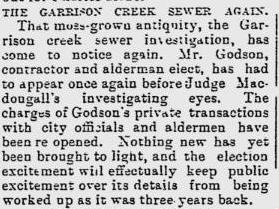Banner photo is of the SW corner of Duncan and Queen in 2015. Photo by K Taylor.
The four brick beauties you see here, on the south-west corner of Queen W. at Duncan, have been banded together for a very long time. The two currently painted up like Halloween decorations, Civello’s and it’s neighbour Pie 24/7 (tip: no actual pie on hand, around the clock or otherwise), were the first to be built in 1876. The second, taller pair to the west were added in 1889. All four were built on land owned by an enterprising fellow named A. W. Godson.
Born in Brailes, Warwickshire, England on January 8th, 1845, Arthur William Godson came to Canada with his parents and six siblings when he was but 4 years old. By his mid-20s he owned his own flour and feed store on Queen W. near Simcoe and for a short time even offered his services as an insurance agent. It was about this time that he’d also begun a career as, what appears to have been his true calling, a contractor. Now that may not sound very remarkable but I promise you it is. But I’ll get to that in a bit.
His pursuits in flour, feed and construction must’ve turned a penny or two because he started to accumulate land, including the site of our four buildings. He purchased this large rectangular lot in 1876 and built the first set of buildings on the corner. He moved his flour and feed business into what is now Civello’s and built a home for his family at the south end of the block, near Richmond. The neighbouring building on Queen was rented out to a doctor named J. S. Diamond. I suspect that Dr. Diamond was fairly enterprising himself as he also had a sideline as the proprietor of a Turkish Bath in the building.
Godson’s contracting business really seemed to take off in the early 1880s. During this period, he was credited with having paved two-thirds of Toronto’s streets – no mean feat. He was also responsible for building the Queen St. Subway in Parkdale, the Eastern Avenue Bridge over the Don River and perhaps most interestingly, one half of the Garrison Creek sewer.
The sewage situation in 1880’s Toronto was not the happy affair it is today, needless to say. According to a study in 1883 by the Medical Officer of Health, Dr. William Canniff, the majority of the population were using privy pits and much of the waste from these was being discharged into watercourses. The Garrison Creek, which flowed south from St. Clair down to Bathurst and Lakeshore, had basically become an open sewer. In a bid to limit infectious diseases, improve sanitary conditions and cut down on evil smells, Dr. Canniff demanded that the creek be channeled underground. City Council acquiesced. The large job of burying the creek was split between two contractors, A. J. Brown and our Arthur Godson. Brown would handle the section from Wellington up to Queen, and Godson would manage Queen north to College.
Now, I don’t want to cast any aspersions on Mr. Godson’s character (that sounds like I’m about to, doesn’t it), especially as I’m viewing him from the distance of a century, but I do have to say that he seemed to elicit a lot of bad blood. Of course, I understand that you’re not likely to please everyone when you undertake large public projects. So I take with a grain of salt the handful of people in Parkdale who sued Godson for damaging their property in his building of the Queen St. Subway. But then you have the odd case that cropped up after the Eastern Avenue Bridge was built, in which – according to The Ontario Reports, Volume 16, 1889 – he was accused of taking “large sums of money to which he was not entitled.” No formal charge seems to have come of that though, so it’s a bit tricky to sort out. Perhaps a little more concrete – though, sadly, not literally – is the fact that a portion of Godson’s Garrison Creek sewer collapsed. Even before the collapse, inspectors were reporting that Godson had employed shoddy workmanship, was using poor materials and that the sewer’s gradient was too shallow. And that’s where the bad blood really seems to pool.
Along with the engineer, the city inspector and the city commissioner, Godson was brought before a judicial inquiry in 1885. The others got off fairly unscathed, but Godson was found guilty of grave misconduct and breach of duty. I’m afraid I don’t know what price he had to pay for this but it certainly couldn’t have been much. The worst of it was probably The Globe newspaper calling Godson’s work “a scandalous job” – but then he smacked them right back with a $20, 000 libel suit. Still, the matter cropped up from time to time:

But by all appearances, Godson continued to truck along just fine. Having sold his flour and feed business in 1886, he’d eventually moved out of the corner building at Duncan and Queen and sold off the lot. But then, by that point, he had 72 other properties spread out over the city to worry about.
I love the Halloween colours! Are they painted like that all the time? And how disappointing that Pie 24/7 doesn’t actually sell pie! You shouldn’t promise pie and then not follow through!
LikeLiked by 1 person
Yep! They’ve been painted like that for some time. I like it too, makes the block much more lively. And I’m with you on the lack of pie – very disingenuous of them. Apparently they’re not even remotely pie-related. It’s some oddball entrepreneurial academy, whatever that might be.
LikeLiked by 1 person
Pfft, well that business doesn’t sound like it’s going to last very long. Failing to deliver on pie is a recipe for disaster (pun intended)!
LikeLiked by 1 person
Ha!
LikeLike